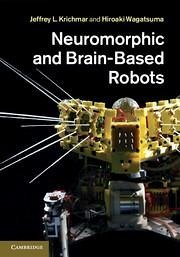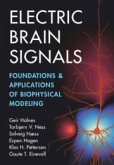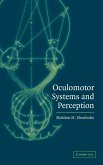Neuromorphic and Brain-Based Robots
Herausgeber: Krichmar, Jeffrey L; Wagatsuma, Hiroaki
Neuromorphic and Brain-Based Robots
Herausgeber: Krichmar, Jeffrey L; Wagatsuma, Hiroaki
- Gebundenes Buch
- Merkliste
- Auf die Merkliste
- Bewerten Bewerten
- Teilen
- Produkt teilen
- Produkterinnerung
- Produkterinnerung
This book is an introduction to recent advances in neuromorphic robotics and its contribution to furthering our understanding of the brain.
Andere Kunden interessierten sich auch für
![Electric Brain Signals Electric Brain Signals]() Geir HalnesElectric Brain Signals167,99 €
Geir HalnesElectric Brain Signals167,99 €![Spatial Cognition, Spatial Perception Spatial Cognition, Spatial Perception]() Spatial Cognition, Spatial Perception230,99 €
Spatial Cognition, Spatial Perception230,99 €![Oculomotor Systems and Perception Oculomotor Systems and Perception]() Sheldon M. EbenholtzOculomotor Systems and Perception140,99 €
Sheldon M. EbenholtzOculomotor Systems and Perception140,99 €![The Human Brain The Human Brain]() William Bevan LewisThe Human Brain36,99 €
William Bevan LewisThe Human Brain36,99 €![The Systems View of Life The Systems View of Life]() Fritjof CapraThe Systems View of Life27,99 €
Fritjof CapraThe Systems View of Life27,99 €![What Makes Biology Unique? What Makes Biology Unique?]() Ernst MayrWhat Makes Biology Unique?74,99 €
Ernst MayrWhat Makes Biology Unique?74,99 €![Biological Evolution Biological Evolution]() Mike CassidyBiological Evolution147,99 €
Mike CassidyBiological Evolution147,99 €-
-
-
This book is an introduction to recent advances in neuromorphic robotics and its contribution to furthering our understanding of the brain.
Hinweis: Dieser Artikel kann nur an eine deutsche Lieferadresse ausgeliefert werden.
Hinweis: Dieser Artikel kann nur an eine deutsche Lieferadresse ausgeliefert werden.
Produktdetails
- Produktdetails
- Verlag: Cambridge University Press
- Seitenzahl: 376
- Erscheinungstermin: 17. Oktober 2011
- Englisch
- Abmessung: 262mm x 182mm x 23mm
- Gewicht: 877g
- ISBN-13: 9780521768788
- ISBN-10: 0521768780
- Artikelnr.: 33216218
- Herstellerkennzeichnung
- Libri GmbH
- Europaallee 1
- 36244 Bad Hersfeld
- gpsr@libri.de
- Verlag: Cambridge University Press
- Seitenzahl: 376
- Erscheinungstermin: 17. Oktober 2011
- Englisch
- Abmessung: 262mm x 182mm x 23mm
- Gewicht: 877g
- ISBN-13: 9780521768788
- ISBN-10: 0521768780
- Artikelnr.: 33216218
- Herstellerkennzeichnung
- Libri GmbH
- Europaallee 1
- 36244 Bad Hersfeld
- gpsr@libri.de
List of contributors; Preface; Part I. Introduction: 1. History and
potential of neuromorphic robotics Jeffrey L. Krichmar and Hiroaki
Wagatsuma; Part II. Neuromorphic Robots: Biologically and Neurally Inspired
Designs: 2. Robust haptic recognition by anthropomorphic hand through
repetitive grasping Koh Hosoda; 3. Biomimetic robots as scientific models:
a view from the whisker tip Ben Mitchinson, Martin J. Pearson, Anthony G.
Pipe and Tony J. Prescott; 4. Sensor-rich robots driven by real-time brain
circuit algorithms Andrew Felch and Richard Granger; Part III. Brain-Based
Robots: Architectures and Approaches: 5. RatSLAM project: robot spatial
navigation Gordon Wyeth, Michael Milford, Ruth Schulz and Janet Wiles; 6.
Evolution of rewards and learning mechanisms in cyber rodents Eiji Uchibe
and Kenji Doya; 7. A neuromorphically-inspired cognitive architecture for
cognitive robots Mitch Wilkes, Erdem Erdemir and Kazuhiko Kawamura; 8.
Autonomous visuomotor development for neuromorphic robots Zhengping Ji,
Juyang Weng and Danil Prokhorov; 9. Brain-inspired robots for autistic
training and care Emilia I. Barakova and Loe Feijs; Part IV. Philosophical
and Theoretical Considerations: 10. From hardware and software to kernels
and envelopes: a concept shift for robotics, developmental psychology and
brain sciences Frederic Kaplan and Pierre-Yves Oudeyer; 11. Can cognitive
developmental robotics shift the paradigm? Minoru Asada; 12. A look at the
hidden side of situated cognition: a robotic study of
brain-oscillation-based dynamics of instantaneous, episodic and conscious
memories Hiroaki Wagatsuma; 13. The case for using brain-based devices to
study consciousness Jason Fleischer, Jeffrey McKinstry, David Edelman and
Gerald Edelman; Part V. Ethical Considerations: 14. Ethical implications of
intelligent robots George A. Bekey, Patrick Lin and Keith Abney; 15. Toward
robot ethics through the Ethics of Autism Masayoshi Shibata; Index.
potential of neuromorphic robotics Jeffrey L. Krichmar and Hiroaki
Wagatsuma; Part II. Neuromorphic Robots: Biologically and Neurally Inspired
Designs: 2. Robust haptic recognition by anthropomorphic hand through
repetitive grasping Koh Hosoda; 3. Biomimetic robots as scientific models:
a view from the whisker tip Ben Mitchinson, Martin J. Pearson, Anthony G.
Pipe and Tony J. Prescott; 4. Sensor-rich robots driven by real-time brain
circuit algorithms Andrew Felch and Richard Granger; Part III. Brain-Based
Robots: Architectures and Approaches: 5. RatSLAM project: robot spatial
navigation Gordon Wyeth, Michael Milford, Ruth Schulz and Janet Wiles; 6.
Evolution of rewards and learning mechanisms in cyber rodents Eiji Uchibe
and Kenji Doya; 7. A neuromorphically-inspired cognitive architecture for
cognitive robots Mitch Wilkes, Erdem Erdemir and Kazuhiko Kawamura; 8.
Autonomous visuomotor development for neuromorphic robots Zhengping Ji,
Juyang Weng and Danil Prokhorov; 9. Brain-inspired robots for autistic
training and care Emilia I. Barakova and Loe Feijs; Part IV. Philosophical
and Theoretical Considerations: 10. From hardware and software to kernels
and envelopes: a concept shift for robotics, developmental psychology and
brain sciences Frederic Kaplan and Pierre-Yves Oudeyer; 11. Can cognitive
developmental robotics shift the paradigm? Minoru Asada; 12. A look at the
hidden side of situated cognition: a robotic study of
brain-oscillation-based dynamics of instantaneous, episodic and conscious
memories Hiroaki Wagatsuma; 13. The case for using brain-based devices to
study consciousness Jason Fleischer, Jeffrey McKinstry, David Edelman and
Gerald Edelman; Part V. Ethical Considerations: 14. Ethical implications of
intelligent robots George A. Bekey, Patrick Lin and Keith Abney; 15. Toward
robot ethics through the Ethics of Autism Masayoshi Shibata; Index.
List of contributors; Preface; Part I. Introduction: 1. History and
potential of neuromorphic robotics Jeffrey L. Krichmar and Hiroaki
Wagatsuma; Part II. Neuromorphic Robots: Biologically and Neurally Inspired
Designs: 2. Robust haptic recognition by anthropomorphic hand through
repetitive grasping Koh Hosoda; 3. Biomimetic robots as scientific models:
a view from the whisker tip Ben Mitchinson, Martin J. Pearson, Anthony G.
Pipe and Tony J. Prescott; 4. Sensor-rich robots driven by real-time brain
circuit algorithms Andrew Felch and Richard Granger; Part III. Brain-Based
Robots: Architectures and Approaches: 5. RatSLAM project: robot spatial
navigation Gordon Wyeth, Michael Milford, Ruth Schulz and Janet Wiles; 6.
Evolution of rewards and learning mechanisms in cyber rodents Eiji Uchibe
and Kenji Doya; 7. A neuromorphically-inspired cognitive architecture for
cognitive robots Mitch Wilkes, Erdem Erdemir and Kazuhiko Kawamura; 8.
Autonomous visuomotor development for neuromorphic robots Zhengping Ji,
Juyang Weng and Danil Prokhorov; 9. Brain-inspired robots for autistic
training and care Emilia I. Barakova and Loe Feijs; Part IV. Philosophical
and Theoretical Considerations: 10. From hardware and software to kernels
and envelopes: a concept shift for robotics, developmental psychology and
brain sciences Frederic Kaplan and Pierre-Yves Oudeyer; 11. Can cognitive
developmental robotics shift the paradigm? Minoru Asada; 12. A look at the
hidden side of situated cognition: a robotic study of
brain-oscillation-based dynamics of instantaneous, episodic and conscious
memories Hiroaki Wagatsuma; 13. The case for using brain-based devices to
study consciousness Jason Fleischer, Jeffrey McKinstry, David Edelman and
Gerald Edelman; Part V. Ethical Considerations: 14. Ethical implications of
intelligent robots George A. Bekey, Patrick Lin and Keith Abney; 15. Toward
robot ethics through the Ethics of Autism Masayoshi Shibata; Index.
potential of neuromorphic robotics Jeffrey L. Krichmar and Hiroaki
Wagatsuma; Part II. Neuromorphic Robots: Biologically and Neurally Inspired
Designs: 2. Robust haptic recognition by anthropomorphic hand through
repetitive grasping Koh Hosoda; 3. Biomimetic robots as scientific models:
a view from the whisker tip Ben Mitchinson, Martin J. Pearson, Anthony G.
Pipe and Tony J. Prescott; 4. Sensor-rich robots driven by real-time brain
circuit algorithms Andrew Felch and Richard Granger; Part III. Brain-Based
Robots: Architectures and Approaches: 5. RatSLAM project: robot spatial
navigation Gordon Wyeth, Michael Milford, Ruth Schulz and Janet Wiles; 6.
Evolution of rewards and learning mechanisms in cyber rodents Eiji Uchibe
and Kenji Doya; 7. A neuromorphically-inspired cognitive architecture for
cognitive robots Mitch Wilkes, Erdem Erdemir and Kazuhiko Kawamura; 8.
Autonomous visuomotor development for neuromorphic robots Zhengping Ji,
Juyang Weng and Danil Prokhorov; 9. Brain-inspired robots for autistic
training and care Emilia I. Barakova and Loe Feijs; Part IV. Philosophical
and Theoretical Considerations: 10. From hardware and software to kernels
and envelopes: a concept shift for robotics, developmental psychology and
brain sciences Frederic Kaplan and Pierre-Yves Oudeyer; 11. Can cognitive
developmental robotics shift the paradigm? Minoru Asada; 12. A look at the
hidden side of situated cognition: a robotic study of
brain-oscillation-based dynamics of instantaneous, episodic and conscious
memories Hiroaki Wagatsuma; 13. The case for using brain-based devices to
study consciousness Jason Fleischer, Jeffrey McKinstry, David Edelman and
Gerald Edelman; Part V. Ethical Considerations: 14. Ethical implications of
intelligent robots George A. Bekey, Patrick Lin and Keith Abney; 15. Toward
robot ethics through the Ethics of Autism Masayoshi Shibata; Index.








